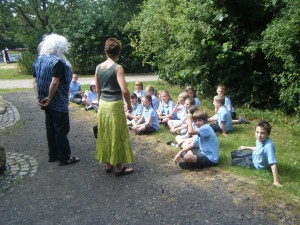by Frank Cottrell Boyce
In the evenings, on the boat, I’m reading The River at Greene Knowe. In it a group of refugee children staying at the ancient house Green Knowe, potter about on the river. One day they find a windlass – for opening lock gates – a key that unlocks the heart of the river for them, allowing them passage into all its secret by ways and remotest reaches. There’s something magical about passing through locks – the smooth speed of the water’s sinking, the weed-plastered walls rising around you. I silently thank the Victorian navigators for their inbuilt courtesies – the marker that tells you where the sill is, the low-tech, high intelligence of the design itself. The massive gates won’t budge at all until the water is completely level but then they slide apart like curtains, always revealing something new. After all, the lock is a lift and it takes you to a new floor of the river – a different department. It’s a good job I feel so positive about them because a few miles below Adlington, we hit the Wigan Flight, a sequence of 21 locks in succession, dropping two hundred and odd feet in a mile or so. Most of the pleasure traffic tootles upto it, then turns around and heads home. But we are not here for pleasure. We are here to save the planet. This is extreme narrow boating.
It turns out that Ben – my daughter’s boyfriend – is a genius at the helm and at tying knots, so I go ahead with Steve’s daughter to set the next lock, so we can sail from one straight into the other without waiting. We are going to break all records. For the first five or six locks the only problem is the big cork bobble on the security key. It’s designed to stop the key sinking if you drop it. But it also attracts the attention of the unleashed pit bulls and rottweillers who seem to own the tow path here. At every lock, they slaver around my ankles, wanting to play.
The eighth lock opens into a big pound – a kind of transitional cistern. But when we look into it, we realize it’s almost empty. There is a pleasure cruiser beached in the middle of it. We can’t risk going into it. We have to walk back to the top of the flight, refill a lock and bring more water down. It’s a bizarre task, transporting this block of water, step by step down to the pound, like moving credit from one account to another. It turns out one is not enough and we have to do it again.
We’re knackered now so we tie up for the night and walk to the pub where tonight’s event it to take place. This is a meeting with some representatives of the “Transition Towns” movement – a campaign to make communities more self-reliant. Steve works for the Catholic Archdiocese and thinks that parishes are the perfect place to start. Someone turns up from the Anglican, “Faith4Change” movement, one of the backers of our barge. When the Transition people show up, it turns out that they are “live aboards” – people who live permanently on their boat. It’s a proper, fat barge, not a narrowboat. It’s got a corner tub bath, wireless broadband, a plasma TV and an integral, state-of-the-art pagan altar. Because they are witches. There’s a lot of interesting talk about the practicalities but I just sit there thinking, Catholic Archdiocese, Anglican Synod and a coven of witches. It’s ecumenism gone mad. Above the sink there’s a little postcard that says, “Where there’s a witch, there’s a way.” (to be continued….)
‘There is Nothing in the Water’ by Frank Cottrell Boyce, appears in ‘Caught by the River – A Collection of Words on Water’ out now.
